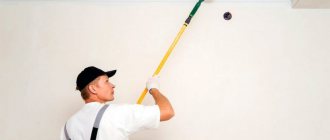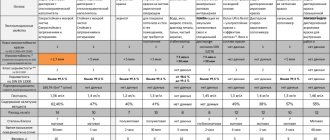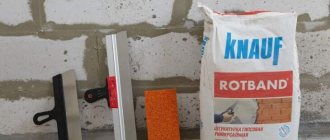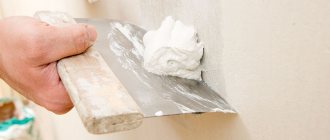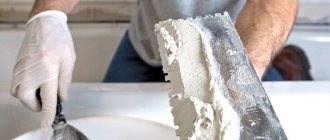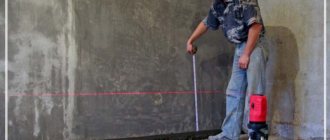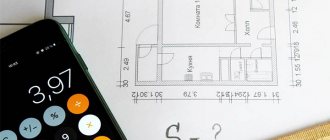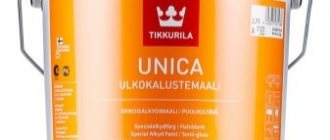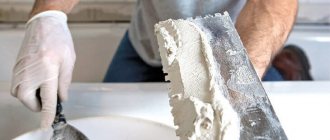Puttying walls under wallpaper is one of the main stages of wall finishing before the actual final application of surface finishing. In order to carry out this type of work as correctly and efficiently as possible, you need to understand what steps should be followed one after another so that the end result is a truly reliable and beautifully created wall of the room. It is not always possible to carry out puttying on your own, so it is best to seek help from an experienced specialist who has some experience in performing this type of construction task. Approximate prices for the work are presented in the article.
Tool for carrying out work
The process of puttying the walls of any room is a rather complex job that requires not only special skills, but also appropriate equipment.
In any case, workers spend part of the money they earn on tools, without which it is simply impossible to make high-quality wall repairs.
Among the most necessary devices that may be needed depending on the severity of the work, workers identify the following:
- drill along with a special attachment that allows you to turn the device into a mixer. In most cases, wall putty is sold as a dry mixture. It requires the addition of a certain amount of water and thorough mixing to give it plasticity and homogeneity;
Drill with attachment
- a set of spatulas of various sizes. In order for the work to proceed quickly and correctly, you need to use both large tools (40-50 centimeters each) and rather small ones (10-15 centimeters);
Set of spatulas
- rollers and brushes with which you can apply the primer. This stage of work should not be skipped, as it ensures proper adhesion of the material to the wall. In order to thoroughly saturate the surface with primer, you need to use different tools of different sizes;
- rule. This tool is needed only in cases where the surface of the walls is very uneven, which is why the putty needs to be applied in a fairly dense layer;
Rule
- building level . Without this tool, it is impossible to insert test beacons, and also after work to evaluate how evenly the wall is made. There is no need to determine this parameter by eye;
Building level
- sandpaper. It is best to use skins with fairly fine particles. This will allow you to slightly correct unevenness in the right places, while obtaining a beautiful surface. Sandpaper is often required at joints and corners of the wall;
- mixing container . In it you need to dilute the dry putty mixture with water, and then prepare the finished material for the walls using a construction mixer.
When determining how much it costs to putty walls under wallpaper, many workers also take into account the cost of their equipment. Most tools are inexpensive, but some of them (drill mixer, level, etc.) are quite expensive.
Also check out mechanical wall plastering.
DefSmeta: ensuring optimal interaction between the estimate department, technical department and supply department
Diffusers for ventilation: types and principle of operation
DefSmeta program
synchronizes lists of actually used resources with all the prices that your organization uses in its activities.
As a result, you will be able to create lists of real resources to supply the facility according to the provided estimate.
But most importantly, you can not only predict the delivery of materials to the site, but also keep records of materials supplied to the construction site and automatically determine how much materials need to be supplied to complete certain work, taking into account how many materials were delivered earlier. DefSmeta program
allows you to do this very quickly and accurately.
Application
Puttying the walls of premises is a rather labor-intensive process that can take a long time. Which putty is best for walls? Currently, there is a large selection of different mixtures.
First of all, you need to prepare the material if you buy a dry mixture.
The process is as follows:
- First, you should pour a small amount of cold water into the container;
- you need to add the dry mixture to the liquid;
- mix the ingredients with a simple spatula;
- For the final preparation of the material, you need to use a construction mixer at high speed.
Preparing the mixture
In order to clearly understand whether the putty is ready, you need to have some experience in this matter. It should be quite flexible and stick a little to the spatula. Water and dry mixture should be added only in small portions so as not to overdo it with their quantity.
Ready mix
When the putty is ready, you can begin applying the material to the wall. In this case, it is best to use large tools, evenly distributing the mixture over the surface of the wall. The material must be applied at an angle of thirty degrees in a diagonal direction to the plane.
Each subsequent layer must be distributed overlapping the previous one.
In order to treat the corners of rooms, professional craftsmen use a corner spatula. It allows you to make smooth joints between the planes of the walls.
Putty with an angle trowel
To begin with, the master applies a small amount of putty to each surface with a regular spatula, and then levels it with an angle tool. After the starting layer of putty has dried, the worker can proceed to the next stage - finishing work.
To do this, use a large and small spatula. Using the second tool, small amounts of putty are applied to the first. After this, a thin layer of material is distributed over a relatively flat surface. The thickness of the finishing putty is approximately 1-2 millimeters.
A master who knows his business understands that it is impossible to continue working until at least one of the previous layers has dried. That is why it is best for a professional worker never to push. This can have a very bad effect on wallpaper in the future, which will be applied too quickly to the wall.
Approximately 12 hours should pass between the starting and finishing putty of the walls. The last layer before wallpaper or paint dries a little faster, since it is thinner.
The price of puttying walls for wallpaper can vary, depending on how large-scale each stage of the work will be.
Crushed stone is the most popular building material, which is used as a filler in various concrete mixtures. Here the density of crushed stone is fraction 5 20.
Sand is most widely used in the construction and repair of houses and various structures. Here is everything about GOST 8736 sand.
Without the use of tile adhesive, it is impossible to make repairs and decoration of the premises. Click on the link to see its consumption.
First of all, this concerns the beginning of leveling the walls, since they can often be too crooked and incorrectly erected. After the wall is completely dry, you can begin the final work - sanding with sandpaper.
Grinding
This will make the surface as smooth and beautiful as possible. On such a wall, the wallpaper will lie parallel to each other without any problems. It is worth noting that the thickness of the wallpaper may affect how many layers of putty should be applied to the wall.
The thinner the topcoat, the more times the leveling layer must be applied. That is, if the wallpaper is quite rough, then using the putty mixture only twice is enough.
If the wallpaper is thin, it is best to do this three times. Thus, the price of putty for wallpaper, even on the same types of walls, can be different.
For more information about wall putty, watch the video:
Facade painting
Painting facades by industrial climbers includes a number of preparatory works (cleaning, minor repairs to plaster). To paint the facades and rear walls of the building, polyvinyl acetate emulsions (PVA), styrene-butadiene, silicone, and acrylic paints with different performance properties are used.
Discount when contacting our company again from 5% to 15%!
Polluted atmospheric air, automobile smog, industrial and peat smoke stain the facades of residential, public, and high-rise buildings in Moscow unusually quickly. Regular washing of facades helps maintain the prestigious appearance of the facade for two to three years.
If buildings in the capital have a longer lifespan, painting of the façade wall or the entire house will be necessary.
On the facades of high-rise buildings, such work is successfully performed by industrial climbers.
For low-rise buildings with damaged plaster, ancient mansions with cornices, gables, stucco, when carrying out complex work, it is rational to work from scaffolding.
Working from scaffolding or ropes is cheaper and easier than ordering a telescopic lift. The choice of painting technology and preparatory work depends on the finishing material, height, and degree of damage to the facade.
What is included in the cost of work?
Puttying walls is a rather labor-intensive process that consists of several stages. They all must be fulfilled, which is why they should never be ignored or skipped.
Experts define the following types of work:
- dismantling the previous layer . The walls should be as clean as possible of all materials that have ever been on them. This applies to paint, wallpaper or glue. This stage of work works best in new buildings, where there is nothing else except plaster;
Surface cleaning
- primer. This part of the repair allows you to ensure a high level of adhesion of the putty to the wall. This is necessary so that the top layer does not fall off or crack;
Primer
- putty _ This stage of work is the most labor-intensive and important. It must be carried out properly according to specially created rules and regulations. The price per m2 of wall putty for wallpaper is calculated primarily for this part of the work;
putty
- grinding. This stage passes quickly and without significant problems.
If you do the work correctly and correctly, you can achieve complete alignment of the walls and good fastening of the wallpaper.
Features of fabric ceiling consumption
Despite the noble appearance and excellent performance, consumables for fabric stretch ceilings have not yet become as widespread as film ones due to their higher cost. Thin and durable fabrics made from polyester impregnated with polyurethane lack elasticity, and unlike vinyl, they do not stretch when heated, but, on the contrary, shrink slightly. Therefore, in order to securely fasten them in baguettes, the area is calculated with a different adjustment - plus 10-15 cm on each side.
In the case of the above example, the width of the strip on the textile ceiling will be at least 4.75 m, and the length - 5.7 m. We get the required quantity: 4.75x5.7 = 27.075 m2, which is 7 and a half square meters more than vinyl. Taking into account the cost of fabric materials, such a ceiling will cost almost twice as much.
The width of the rolls is also different, varying from 3100 to 5100 mm (in increments of 1000, 400 and 600 mm), so for the example given, a 5100 mm sheet is most suitable, while a strip of 350-400 mm remains in the scraps, and the total cost is still will increase slightly.
Approximately how much does it cost to putty a square meter - prices
It’s worth noting right away that the master can finally provide the price for plastering the walls under wallpaper to his client only after inspecting the room where the renovation is planned.
There are several types of wall plastering work, each of which has a certain cost and scope of action.
Approximate prices for wall putty for wallpaper
Builders offer approximately the following prices:
- putty the walls under the wallpaper in two layers. For this type of work, many workers ask for a price of 220 rubles per square meter of processed surface area. Sometimes the cost increases due to the complexity of the task or difficult conditions;
- Puttying walls with finishing putty. This type of work involves creating the last layer of wall leveling immediately before applying wallpaper to it. This type of surface putty also has a fairly average price, which is equal to 220 rubles per square meter;
- drywall putty. A distinctive feature of this type of work is that the main emphasis in it is the sealing of each seam between individual sheets of material;
Sealing seams
- it is almost impossible to install drywall without subsequent putty, which is due both to the lack of thoroughness in its manufacture and to the complexity of such an installation;
- each seam of this material, as well as the places where screws are used on top, must be carefully puttied, thus completely leveling the surface;
- In this case, a minimal amount of putty mixture is used, but such work is relatively expensive - about 250 rubles per square meter;
- putty of window and door slopes. If it is sometimes quite difficult to see unevenness on the wall, then at the junction of different planes such imperfections immediately appear. That is why it is necessary that the door and window slopes in the room be as correct and correct as possible;
Putty on window and door slopes
- This work requires more time and a certain professionalism of the worker. Therefore, it pays more than other putty works. The client will need to pay about 300 rubles per square meter;
- at the same time, the master can additionally increase it depending on the width of the slope;
- primer of walls. Without this stage of work, it is impossible to fully putty the walls, since in this case the material will not be properly held;
- the approximate cost of this stage is only 50 rubles per square meter, which is primarily due to the ease of completing this construction task.
- primer using Betokontakt composition . Working with this material is a little more voluminous, so most often it is somewhat more expensive than a regular primer - about 60 rubles per square meter of plane;
Primer Betokontakt
- paint mesh sticker. Almost always, when applying putty, it is necessary to ensure that it is properly held on the wall. For this, in most cases, a painting mesh is used. The process of working with it is quite simple, but sometimes it requires considerable time;
Painting mesh sticker
- it is paid at a price equal to 100 rubles per square meter;
- removing the old layer of putty from the surface of the walls . Quite often, before preparing a surface for a new finish, it is important to get rid of old materials applied to it;
- this process, depending on how high-quality the initial repair was, can be completely varied;
- in most cases, specialists for this type of work charge about 140 rubles per square meter of wall.
What does the cost depend on to putty the walls?
In order to understand how much it costs to putty walls under wallpaper, you need to know the entire process of carrying out this work. It can be multi-component and quite diverse. Therefore, it is not always worth focusing only on the number of square meters of the room.
In some cases, rooms of the same size will be valued by the master at completely different amounts.
Therefore, be sure to ask a specialist, before he begins the work, what the cost of puttying walls under wallpaper will be in this particular case.
Plaster with fur coat effect ➤ Wall-Clavel
Surface preparation
Before applying the design effect Pelure PE1 - Surface under a fur coat , you must carefully prepare the surface. Surface type No. 2, method 4. Conditions for application: air temperature: from 5°C to 35°C relative air humidity - no more than 75% (recommended - 60%).
Applying the Pelure base coat
- 1The paint for the base layer is diluted with water in an amount of 3-5%. Pelure is applied with a trowel one to two millimeters thick.
- 2After six to eight hours, after the paint has dried, the next layer of Pelure is applied, without diluting it with water. A textured layer is obtained with an average application thickness of three to five millimeters.
- 3It is necessary to immediately begin treating the surface with a structural rubber roller. Movements should begin with unidirectional horizontal movements and continue vertical, using the 50% overlap method.
- 4 Once the paint has acquired elasticity, after 30-60 minutes, the surface is treated with a roller moistened with water, which forms a smoothed wavy relief, similar to the peel of an orange.
- 5Carrying out exterior work with facade paints requires compliance with certain rules: you need to try to prevent sunlight and raindrops from falling on the wet coating. It is most convenient to carry out the work in pairs: entrust one specialist with the application, and the second with the roller processing.
Applying the Pelure topcoat
Features of application on objects
www.stena.ru
